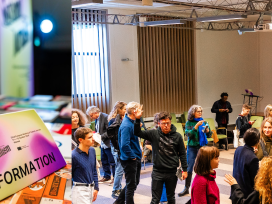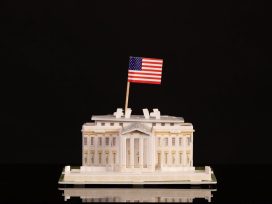In the pages of one of the July 1945 issues of the US Fifth Air Force’s Weekly Intelligence Review is an article supporting the relentless aerial bombardment of Japanese cities. Its author, Colonel Harry F. Cunningham, wrote:
We military men do not pull punches or put on Sunday School picnics. We are making War and making it in the all-out fashion which saves American lives, shortens the agony which War is and seeks to bring about an enduring Peace. We intend to seek out and destroy the enemy wherever he or she is, in the greatest possible numbers, in the shortest possible time. For us, THERE ARE NO CIVILIANS IN JAPAN.
The devastating consequences of such a strategy had already been revealed: two months earlier, on 9-10 March 1945, the firebombing of Tokyo killed an estimated 87,793 people in one night. The moral reality of that dehumanising row of numerals is worth reflecting on. A few weeks after Cunningham’s comments, the US Army Air Force dropped the atomic bombs on Hiroshima and Nagasaki, killing around 200,000 more.
Such acts received broad approval from Americans. Whilst the US government’s own postwar bombing survey found that, contrary to enduring myths, “the Hiroshima and Nagasaki atomic bombs did not defeat Japan”, most of the military establishment had argued during the war that atomic attack was a military necessity. Many ordinary soldiers supported the mass killing of Japanese civilians too – and often irrespective of military need. In surveys conducted between November 1943 and April 1944, American infantrymen were asked: “What would you like to see happen to the Japanese after the war?” Of four thousand infantrymen surveyed in the Pacific theatre, 47 per cent responded “punish leaders but not ordinary Japanese”, nine per cent “make Japanese people suffer plenty”, and 42 per cent answered “wipe out whole Japanese nation”. Amongst the thousand infantrymen surveyed in the European theatre, the proportion of American soldiers supporting an actual genocide of the Japanese people rose to 61 per cent, amongst soldiers in training back in the United States, fully 67 per cent supported such a course. Around a quarter of those surveyed also supported wiping out the whole German nation. There was some support for such stances amongst the American public too. 20 per cent of Americans in December 1944 expressed a desire for Japanese civilians to be tortured, exterminated or otherwise harshly punished after the war. In a survey after the dropping of the atomic bombs, five per cent of respondents opposed any use of atomic weapons, 14 per cent wished there had been a warning demonstration first, 53.5 per cent endorsed the use of two bombs “just as we did”, whilst 23 per cent expressed regret that many more atomic bombs had not been dropped.
The presence of such extreme and dangerous attitudes amongst so many members of a prototypical “liberal” society is shocking, and raises profound and understudied questions for ethical and political theory. Such sentiments in support of mass violence seem more characteristic of the oppressive and genocidal ideologies of Nazi Germany, Mao’s China, the Hutu Power movement in Rwanda or Slobodan Milosevic’s Yugoslavia. Allied bombing was not morally equivalent to the crimes of such regimes. But the attitudes behind it are a stark reminder that the willingness to destroy human life on an epic scale is not limited to the blatantly evil or monstrous. Even the mainstreams of democratic societies are vulnerable to the appeal of destructive and dangerous sentiments when confronted with crisis and fear.
But where exactly did these sentiments come from? Can we connect statements like Colonel Cunningham’s to the prevalence of such attitudes amongst US soldiers and civilians, not to mention the actual practice of mass aerial warfare against Japanese civilians? What was the effect of military orders and political propaganda? How do we establish the actual impact of speech on violent behaviour? Such questions remain as alive now as ever. Many states around the world are plagued by passionate demands for brutal discrimination and intergroup violence. Radicalising calls to extremism and terrorism are at the forefront of political debate. And even in twenty-first-century America, Donald Trump publicly proposed a blanket ban on all Muslims entering the country and received considerable support from certain sections of American society. Do these various forms of speech have a real impact? How dangerous are they?
The paradox of dangerous speech
The answer to such questions involves a paradox. It is extremely difficult, and frequently impossible, to assess the discrete impact of any individual speech act in causing people’s behaviour to change. This is true even when individuals appear to engage in the clearest cases of “incitement”. When an audience responds to a far right call to attack Muslims in “retaliation” for a terrorist incident, for example, how can we be sure they were really moved by that call? Might they not have already desired to engage in such violence? Nihad Awad, national executive director of the Council on American-Islamic Relations, responded to Donald Trump’s words by arguing that: “These are not just words […] Trump and [Ben] Carson’s mainstreaming of Islamophobia in the election is inciting discrimination, hate crimes, [and] violent attacks against Muslims and mosques.” This is highly plausible. But we cannot look inside the heads of those who engage in such discrimination and hate crimes – and it is extremely hard to establish the precise difference Trumps’ words make. We can trace the levels of violence and discrimination over time and note how this seems to correlate with statements by leading public figures. But this is a process fraught with unreliability. There are lots of such statements, as well as exogenous events (like the 2015 Paris attacks) which might be a more powerful trigger of changed attitudes and behaviour. Confidently unravelling and isolating the impact of individual statements from the overall morass of speech and action is close to impossible.
At the same time, however, there is simply no reasonable doubt that speech in general plays a central role in violence and discrimination. Both quantitative and qualitative social science has produced an abundance of evidence on such a role. David Yanagizawa-Drott, for example, conducted a statistical analysis of the impact of the infamous RTLM hate propaganda radio station in the Rwandan genocide. He compared the broadcast strength of the station on a district by district level in Rwanda, and correlated this with evidence of levels of violence while controlling for a range of other factors. His study suggested that a one standard-deviation increase in radio coverage increased participation in violence by 12-13 per cent, and concluded that “10% of the total participation in the genocide […] was caused by the radio station.” Using a very different approach, historian Omar Bartov, in the world’s leading study of the ideological attitudes of the German army in Hitler’s wars, analysed hundreds of soldiers’ letters, internal military communications, and orders from superiors. He found abundant (though complex and varying) internalization of Nazi ideology, which was explicitly and implicitly referenced in explaining participation in violence. These ideas were hardly self-evident interpretations of the world German soldiers found themselves in, nor had they always been in everyone’s heads. They were disseminated through propagandistic speech, of which we have archives of documentary evidence. When we find that soldiers did believe in Nazi framings of their war against the Soviet Union as a racial war of extermination, when we know that they were told this by senior military officers and Nazi elites, and when we know that there were not reasonable ways in which most soldiers would come to such a belief by other means, the only reasonable conclusion is that speech played a significant role.
Many other cases support such findings. Kemal Kurspahiç has tracked the role of Serbian media in the early 1990s in propagating rumours and falsehoods that encouraged strong support for ethnic violence. We know that such propaganda did not merely espouse what Serbians already thought, since both polling data and ethnographic studies have clearly demonstrated that inter-ethnic animosity in 1980s Yugoslavia was weak. Through propaganda and extremist representations of events, attitudes were altered, allowing nationalists to mobilize considerable support for ethnic cleansing and mass killing through sectarian appeals and division. The same is true in the Soviet Union under Joseph Stalin. John Arch Getty’s and Oleg Naumov’s definitive documentary collection and analysis of the Soviet Great Terror in 1937-8 makes clear that Stalinist elites espoused the same ideological understandings and justifications for violence in private as they did in public. In the words of Vojtech Mastny, there was “no double book-keeping” – the elite organizers of violence sincerely believed in the claims and justifications they gave for violence. These justifications were heavily disseminated throughout Soviet society, and studies of Soviet public opinion find that a significant proportion of citizens were convinced by them – often motivating participation in the terror.
There are also more fundamental grounds for concluding that speech must play a central role in shaping peoples’ attitudes and behaviour. Human beings cannot experience most of political and social reality directly. You can’t, for example, personally observe a nation’s overall unemployment, its level of national security, the extent of benefit fraud or the scale of aggregate racism. At most, we can have only our own anecdotal engagements with such phenomena, not the overall. We also can’t be everywhere at once and can’t experience all political events that occur. For everything that we do not experience personally we are, in the words of the philosopher John Hardwig, “epistemically dependent” on others: the newspapers, experts, politicians, friends and colleagues who mediate these bits of reality for us. Such mediation occurs overwhelmingly through speech. The considerable bulk of our knowledge and attitudes about the world around us are necessarily shaped by how the world is represented to us in the speech of others.
The impact speech has
Research on the role of speech in violence thus generates two important conclusions. First, identifying the discrete impact of a particular speech act on violence is generally a futile quest – akin to identifying which strand of a steel cable “really” holds together a suspension bridge. Rarely does a single speech act shift attitudes or provoke behaviour on its own. It is the aggregate and accumulative impact of speech, and its dissemination inside certain structures of ideological production and consumption, which matters. The quote from Cunningham, with which I opened this article, was part of a much vaster, more pervasive welter of explicit and implicit justifications for violence against civilians propagated by the US and British governments during the war. There is no doubt that this shaped policymakers’, soldiers’ and mass publics’ attitudes. But we cannot pin down which individual speech acts mattered most. Sometimes, particular images, speeches, personal experiences or producers of propaganda do play a disproportionately significant role (although even then, only within existing ideological frameworks in part obtained through earlier speech). Sometimes individuals have “conversion experiences” after reading a particular book or in response to a particular event. But in general, dangerous ideological radicalization is a drip-by-drip process of calcification – the gradual shift of attitudes and beliefs in which no single experience or speech act plays the decisive role.
Second, many of the hundreds of individual speech acts that collectively produce that drip-by-drip process do not match our expected stereotypes of horrific hate speech or explicit incitement. Leftwing revolutionary violence in the 1960s and 1970s was critically based on speech, but usually speech that communicated fantastically abstruse Marxist-Leninist theory. The relevant network of beliefs included the claims that a) a class revolution is inevitable and is going to produce a communist utopia, b) this revolution will necessarily be violent in light of existing concentrations of material power, and c) the unjust existing system is upheld by the bourgeoisie as a class. In a different (and almost certainly not dangerous) setting, such claims could be the topic of a university seminar discussion. Yet in certain contexts, the avowal of such claims carries very real dangers of violence. Historically they not only radicalized people towards leftwing terrorism, but also towards state mass killing in the Soviet Union, Mao’s China and Khmer Rouge Cambodia. But these beliefs do not match most contemporary stereotypes of mouth-foaming extremism. Nor do some components of Cunningham’s article. Claims about Japanese civilians’ technical liability in light of Japan’s universal conscription, assertions of the unviability of military alternatives and promises of substantial military benefits need not be infused with hate, but they are very dangerous when unfounded.
So it is critical to appreciate the impact speech has in disseminating the frames, moralized arguments, and claims about matters of fact that can lead people to see violence as permissible and even necessary. But equally, we must resist the urge to reduce dangerous speech to overt and vicious tirades, or to religious and racial hatred. Sometimes, by contrast, it is cool and calculated, pompous and authoritative, regretful but determined, or merely a presumptive appeal to a purported “common sense”.
Focusing solely on hatred and rage risks blinding ourselves to the many more beguiling faces that calls for extremely harmful behaviour can take. Donald Trump is not alone in attempting to whip up hostility over migration and refugees. British tabloid newspapers have long campaigned to keep out and kick out asylum seekers – even when events, like the widely circulated photo of the dead body of Aylan Kurdi on a Turkish beach – highlight how such policies mean death for many. In doing so, they echo with remarkable continuity the arguments that the same papers made in opposing Jewish emigration from Nazi Germany in the 1930s. In such cases the arguments are not overtly hate-filled, but insidious and skilful. So too with more directly dangerous speech.
Responding to the challenge
This all problematizes existing debates on speech in ethical and political theory which remain locked inside concepts like incitement and hate speech. These phenomena do matter, but they are too narrow to get to grips with the complex causal interrelationship between speech, ideas and violence in the real world. They also track the wrong properties of speech. Speech can be hateful without being dangerous, and dangerous without being hateful – ditto for incitement. But it is dangerous speech – speech which is likely to raise the risks of violence – which should really generate the greatest concerns. We can estimate the impact of such speech only probabilistically, contextually and with a wide-view lens. And frequently such speech overlaps with the expression of views which, whilst distasteful, cannot be ruled out from the spectrum of legitimate political debate. Both these factors may make dangerous speech in its entirety an inappropriate object of legal action. Yet it really can be dangerous – and that presents challenges that absolutist commitments to free speech do not plausibly grapple with.
This leads us to two questions. First, what subset of dangerous speech – if any – might still warrant direct legal regulation? For the reasons just mentioned, there seems little reason to think that existing notions of hate speech or incitement accurately track a causally defensible harm-based answer to that question. But some forms of dangerous speech in extreme contexts – where likely to provoke mass killing, for example – may well warrant coercive prevention. Based on his analysis of its phenomenally vicious propaganda, Yanigazawa-Drott estimated that the US disabling or destroying the RTLM radio transmitters (as was requested by the UN force commander in Rwanda) would have saved around 50,000 lives. That can be contested, but if the station had even a fraction of that impact, it is surely hard to be moved by arguments that such genocide-justifying speech should be protected.
Most dangerous speech is not so extreme, nor can such extensive harm from it be confidently predicted. This raises a second, equally important question: how we do deploy power – on the part of both the state and civil society – to counteract the majority of weaker dangerous speech in ways that do not amount to direct censorship or blanket criminalization? There may be moral obligations to engage in counterspeech against those who espouse dangerous speech online, for example. And the state may have more subtle roles to play in blocking certain abuses of speech. In a world of increasing epistemic dependence on the media, it is extremely worrying that western democracies have seen robust regulatory frameworks for the maintenance of high journalistic standards largely dismantled in recent decades – and through regulatory capture rather than democratic decision-making. Such frameworks need not ban speech outright or even engage in prior censorship. Prohibitions on framing misleading or unsourced information as “news” in no way prevents a newspaper from including it within explicit opinion pages, for example. And some forms of potentially harmful false reporting may be legitimately restricted. This, in my view, is analogous to denying companies the ability to lie about their products, or preventing non-accredited health professionals from falsely claiming to be “doctors”.
Two key criteria should run through such cases: a) is the speech dangerous – i.e. likely to lead to grievous harm to individuals and b) do information asymmetries make it unreasonable to expect ordinary consumers of news to reject or counter the speech? The second criteria is critical since the “marketplace of ideas” is something of a myth: in real life, the question of whether false or dangerous ideas will fail is a highly contingent one, and many complete falsehoods retain consistent levels of support from sizeable majorities. When these two conditions are met, we have the foundations of a case for restricting or regulating speech in some way – though again, this should hardly ever, if ever, mean banning it outright.
Or, maybe I’m wrong – and absolutist defences of free speech should win out. But either way, the question of what sorts of dangerous speech require what sorts of response is the proper framing of this debate, and the proper response to our dual anxiety about protecting freedom whilst recognising that speech can be harmful – often severely harmful. An exclusive focus on incitement and hate speech, by contrast, works with the wrong conceptual tools, and thereby misdirects both advocates and opponents of restricting speech.







